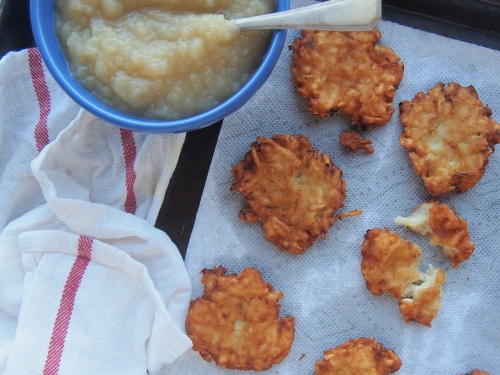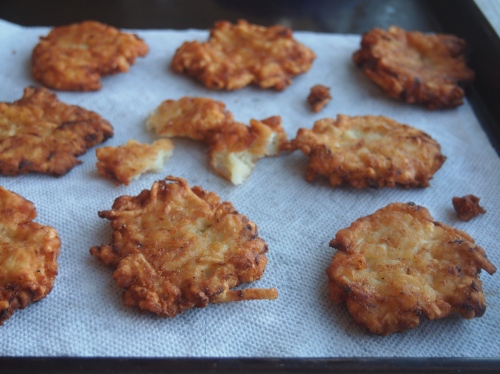Procrastifry
(prə-kra-stə-frī)
verb: to make latkes instead of working when you realize it’s your last chance to fry before the end of Hanukkah because you’re heading out of town for your birthday
I guess the question though is whether I had put off the frying or the working. Or, at this point over a month later, whether I put off the posting as well. Clearly all three.

It began when I attended a discussion at 92Y (disclosure, I received a press ticket) between Melissa Clark and the duo behind the new cookbook Israeli Soul (and Zahav and Federal Donuts and The Rooster and, and, and…), Michael Solomonov and Steve Cook. Towards the end of the evening, the subject of latkes came up, and Clark probed for any tips. Solomonov wondered out loud whether starting with frozen hash brown potato shreds could be a good strategy – not because they’re easier (though they are), but because they are often par-cooked so you avoid the burnt outside raw inside problem. He explained how at Goldie, their vegan falafel spot, their famously extra crispy fries are achieved not by double or triple frying like most places but by par-cooking the potato sticks and then freezing them overnight to dehydrate the surface. Pre-cooked potatoes need less time in oil; dehydrated potatoes get less greasy.
Picking up a bag of hash browns on the way home – this was Wednesday night, if you’re keeping track – I fell asleep awash in the blue glow of my phone, opening page after page of how-tos on frying latkes and, by extension, hash browns, focusing on how to par-cook and dry out the spuds. Thursday, I poked around a little more. And more. And more.
I decided I was going to base my latkes off of Bonnie Benwick’s recipe for hash brown latkes in the Washington Post (which is adapted from Kosher Everyday, the only change is subbing caramelized onions for diced) and one from America’s Test Kitchen because, you know, they test things annoyingly painfully thoroughly. To be even more complete, I checked out Serious Eats for latke tips and those for hash browns. And a little bit of frying science. And, oh my god, are you exhausted yet? Because I am. No wonder I couldn’t face the oil until Friday.
To save you the time and effort of reading every. single. one. of. these. links. here are the main things I learned:
- hash browns are a good shortcut
- but most of the time, they’re not actually par-cooked
- par-cooking is helpful and is most easily achieved in the microwave – 2 minutes for a pound
- par-cooking does two things – first, the latke outsides are less likely to burn before the insides are cooked since they’re, you know, already mostly cooked
- second, it dehydrates the potato shreds
- apparently, when the starch in potatoes is heated above 137F (if we’re going to be exact, thank you Amerca’s Test Kitchen), it absorbs water molecules and the mixture becomes a gel and the surface is essentially drier
- too much moisture on the surface of the potatoes lowers the temperature of the oil, lengthens the time it takes for the crust to form, and allows too much oil to enter the inside of the latke, hence greasy latkes
- little moisture and lots of starch on the surface of the potatoes allows the oil to very quickly form a crust out of the starch which blocks too much oil from come inside the latke while also maintaining a fairly stable oil temperature
- or, according to a food scientist whose blog I found, “In general, the amount of oil absorbed into the food is equal to the amount of water that is removed during frying”
- this is also why you want to wring out as much liquid from the potatoes as you can before the whole microwaving thing begins
If you glossed over this, the only thing to remember is to wring out and microwave your hash browns, and then proceed however you normally do.
Also, don’t wait until the last minute. Unless you want to miss your train home for the weekend.
Hash brown latkes
Makes about a dozen 2-inch latkes
Defrost 1 lb hash browns overnight on a paper towel-lined baking sheet in the refrigerator. Gather the potato shreds in a thin cotton towel or several layers of cheese cloth along with 1/2 an onion, grated (about 1/4 cup), and twist until you wring out as much moisture as you can. Transfer the potatoes mixture from towel to a bowl, and microwave for 2 minutes. Mix in 1/4 t baking powder, 2 T potato starch, 1 t kosher salt, and 1 egg.
If you’re going to eat the latkes immediately, line a plate or baking sheet with more paper towels. If you’re going to freeze the latkes, set out a cooling rack over a baking sheet.
Heat about a quarter-inch of vegetable oil in a cast iron pan – it’s ready when you drop in a potato shred and it bubbles like crazy and quickly browns but doesn’t burn. If you want, use a thermometer – the temperature should be around 350F. Make a small test latke to see if you need to add any salt, and adjust if necessary. Then gently drop large spoonfuls of batter into the oil – about 3-4 depending on the size of your pan – and spread the out a little bit. After about 2-3 minutes, a golden crust should have formed up the sides of each latke and it’s time to flip. Another 2-3 minutes and you’re done. Transfer the warm latkes to the paper towels or cooling rack, and do it all over again. You may need to adjust the flame if the latkes are cooking too fast or too slow (or, you know, pull out the thermometer again). Between batches, remove any rogue burnt bits of potato.
Eat with applesauce (homemade if you’re fancy). Sour cream, if you must.
Otherwise, put the latkes in bags in the freezer (if you’re lucky enough to have a huge freezer, first freeze the latkes in a single layer so they don’t stick together in the bag) until you’re ready to eat at which point you can pop the, straight into a 425F oven for 15-20 minutes. (Since you didn’t mop up all the oil straight out of the pan, the latkes won’t dry out when reheating.) Then, eat with applesauce.

